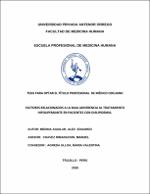Factores relacionados a la baja adherencia al tratamiento hipolipemiante en pacientes con dislipidemia

View/
Download
(application/pdf: 805.9Kb)
(application/pdf: 805.9Kb)
Date
2020Author(s)
Medina Aguilar, Alex Eduardo
Metadata
Show full item recordAbstract
El propósito del estudio fue determinar si el conocimiento inadecuado
sobre la enfermedad, polifarmacia, disfunción familiar, el sedentarismo y
características sociodemográficas, son factores relacionados a la baja adherencia
del tratamiento hipolipemiante en pacientes con dislipidemia en consultorios
externos de medicina interna.
Material y Métodos: Se realizó un estudio analítico, observacional, transversal, con
un tamaño de muestra de 161 pacientes, que cumplieron con los criterios de
selección. Para determinar la relación entre los factores y la adherencia al
tratamiento se usó Odd Ratio de prevalecía (ORp) con su respectivo intervalo de
confianza del 95%, además se corroboró la relación con el análisis bivariado de Chi
Cuadrado de Pearson y análisis multivariado de regresión logística; la significancia
estadística es del 5% (p < 0,05).
Resultados: En el análisis bivariado, el conocimiento de la enfermedad [ORp
2,57(IC 95%: 1,26-5,23)] y disfunción familiar [ORp 41,42 (IC 95%:15,58-110,09)]
constituyeron un factor asociados a baja adheerencia (p<0,05). Las variables
polifarmacia [ORp 0.774 (IC 95%: 0.448-1.337)], procedencia [ORp 0.776 (IC 95%:
0.420-1.433)], no presentaron significancia estadística. Además, variable edad (p=
0.035), grado de instrucción (p= 0.04) y estado civil (p= 0.024) presentaron
significancia estadística y se asocian a la baja adherencia.
Con el análisis multivariado se evidenció también que salieron significativos para
nuestro estudio, conocimiento de la enfermedad (p=0.027), [ORa 3.32 (IC 95%:
1.148-9.620)] y la disfunción familiar (p=0.00), [ORa 45.423 (IC 95%: 16.1312
127.899].
Conclusiones: La falta de conocimiento de la enfermedad y la disfunción familiar,
son factores de asociados a la baja adherencia al tratamiento hipolipemiante, y
dentro de las variables sociodemográficas la edad, estado civil y grado de
instrucción se relacionan a esta baja adherencia The purpose of the study was to determine whether inadequate
knowledge about the disease, polypharmacy, family dysfunction, sedentary lifestyle
and sociodemographic characteristics, are factors related to the low adherence of
lipid lowering treatment in patients with dyslipidemia in external internal medicine
offices.
Material and methods: An analytical, observational, cross-sectional study was
conducted with a sample size of 161 patients, who met the selection criteria. In
addition, to determine the relationship between factors and adherence to treatment,
ORp was used with its respective 95% confidence interval, and the relationship with
Pearson's Chi-square bivariate analysis and multivariate logistic regression analysis
were corroborated; The statistical significance is 5% (p <0.05).
Results: When performing bivariate analysis, knowledge of the disease [ORp 2.57
(95% CI: 1.26-5.23)] and family dysfunction [ORp 41.42 (95% CI: 15.58-110.09) ]
constituted a factor associated with low adhesion (p <0.05). The polypharmacy
variables [ORp 0.774 (95% CI: 0.448-1.337)], provenance [ORp 0.776 (95% CI:
0.420-1.433)], did not show statistical significance. In addition, variable age (p =
0.035), degree of instruction (p = 0.04) and marital status (p = 0.024) presented
statistical significance and are associated with low adherence.
With the multivariate analysis it was also evidenced that they were significant for our
study, knowledge of the disease (p = 0.027), [ORa 3.32 (95% CI: 1.148-9.620)] and
family dysfunction (p = 0.00), [ORa 45.423 (95% CI: 16.1312 127.899].
Conclusions: Lack of knowledge of the disease and family dysfunction are factors
associated with low adherence to lipid lowering treatment, and withi n the
sociodemographic variables age, marital status and degree of instruction are related
to this low adherence.
Collections
- Medicina Humana [2969]

